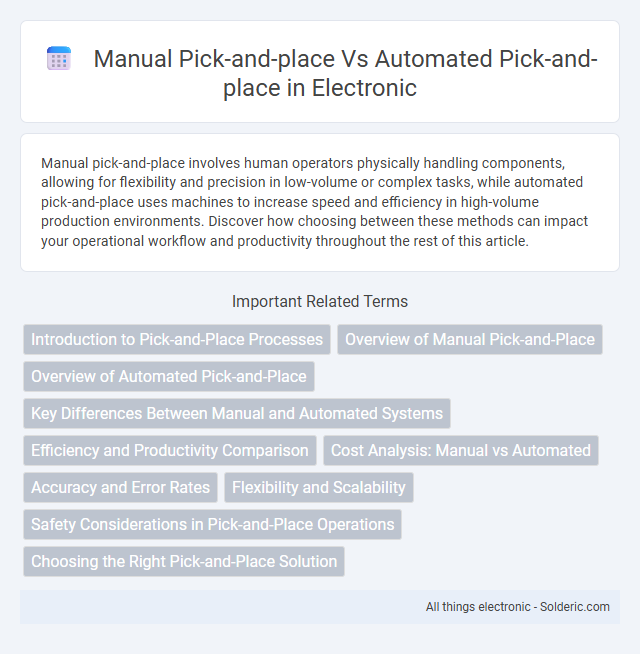Manual pick-and-place involves human operators physically handling components, allowing for flexibility and precision in low-volume or complex tasks, while automated pick-and-place uses machines to increase speed and efficiency in high-volume production environments. Discover how choosing between these methods can impact your operational workflow and productivity throughout the rest of this article.
Comparison Table
| Feature | Manual Pick-and-Place | Automated Pick-and-Place |
|---|---|---|
| Speed | Slow, limited by human pace | Fast, consistent cycle times |
| Accuracy | Moderate, human error prone | High precision, minimal errors |
| Labor Cost | High, ongoing wages | Lower long-term, initial investment |
| Flexibility | High, easy to adjust tasks | Moderate, reprogramming required |
| Scalability | Limited by workforce size | High, suits mass production |
| Consistency | Variable, dependent on operator | Uniform output quality |
| Safety | Dependent on ergonomics | Improved, reduces human risk |
Introduction to Pick-and-Place Processes
Pick-and-place processes involve transferring components from one location to another, essential for assembly lines and manufacturing efficiency. Manual pick-and-place relies on human operators to handle and position parts, offering flexibility but limited speed and consistency. Automated pick-and-place systems use robotic arms and vision technology to enhance precision, throughput, and scalability in production environments.
Overview of Manual Pick-and-Place
Manual pick-and-place involves operators physically selecting and positioning components or products, relying heavily on human dexterity and precision. This method is common in small-scale operations or when handling delicate, customized items that require careful attention. Despite lower efficiency and higher labor costs compared to automated systems, manual pick-and-place offers flexibility and ease of adaptation to complex or varied tasks without extensive setup.
Overview of Automated Pick-and-Place
Automated pick-and-place systems utilize robotic arms and advanced sensors to perform repetitive tasks with high speed and precision, significantly reducing human error and labor costs compared to manual pick-and-place operations. These systems are equipped with machine vision and programming flexibility, allowing them to handle complex assemblies and varied product geometries efficiently. By integrating automated pick-and-place technology, your production line can achieve enhanced consistency, scalability, and throughput in manufacturing processes.
Key Differences Between Manual and Automated Systems
Manual pick-and-place systems rely on human operators to handle tasks, offering flexibility and low initial costs but limited speed and consistency. Automated pick-and-place systems utilize robotics and sensors to achieve higher precision, faster throughput, and reduced labor costs, making them ideal for large-scale production. The key differences include automation level, operational efficiency, error rates, and scalability in manufacturing environments.
Efficiency and Productivity Comparison
Automated pick-and-place systems significantly enhance efficiency by operating at higher speeds and with greater precision than manual methods, reducing cycle times and minimizing errors. These systems enable continuous operation without fatigue, boosting overall productivity and throughput on production lines. Manual pick-and-place, while flexible for small-scale or custom tasks, typically results in slower processing and increased labor costs, limiting scalability.
Cost Analysis: Manual vs Automated
Manual pick-and-place operations incur lower upfront costs due to minimal equipment investment but experience higher labor expenses and slower throughput over time. Automated pick-and-place systems require significant initial capital for robotics and integration, yet they deliver consistent speed, reduced labor costs, and enhanced accuracy, leading to improved long-term cost efficiency. Evaluating total cost of ownership highlights automation's advantage in high-volume manufacturing despite higher initial expenditure.
Accuracy and Error Rates
Automated pick-and-place systems offer significantly higher accuracy compared to manual methods, with error rates reduced to less than 1% due to precise robot calibration and advanced vision systems. Manual pick-and-place relies heavily on human skill and attention, leading to variable accuracy and error rates often exceeding 5%. Integration of machine learning algorithms in automated systems further minimizes errors by continuously optimizing placement precision and detecting anomalies in real-time.
Flexibility and Scalability
Manual pick-and-place operations offer high flexibility for small-scale tasks and custom handling of diverse items, adapting easily to changes in product types or assembly processes. Automated pick-and-place systems provide superior scalability, efficiently managing high-volume production with consistent precision and speed, ideal for large-scale manufacturing environments. Your choice depends on balancing the need for adaptability with the demand for repeatable, high-throughput performance.
Safety Considerations in Pick-and-Place Operations
Manual pick-and-place operations carry higher risks of repetitive strain injuries and ergonomic hazards due to constant human involvement. Automated pick-and-place systems integrate safety features such as sensors, emergency stop functions, and guarded enclosures to minimize accidents and protect workers. Implementing robotic arms and collaborative robots (cobots) reduces exposure to hazardous environments, enhancing overall workplace safety in manufacturing and packaging industries.
Choosing the Right Pick-and-Place Solution
Selecting the right pick-and-place solution depends on factors such as production volume, precision requirements, and budget constraints. Manual pick-and-place systems offer flexibility and lower initial costs, ideal for small-scale or prototype production. Automated pick-and-place solutions provide higher speed, accuracy, and consistency, making them suitable for large-scale manufacturing and complex assembly tasks.
Manual pick-and-place vs automated pick-and-place Infographic

 solderic.com
solderic.com